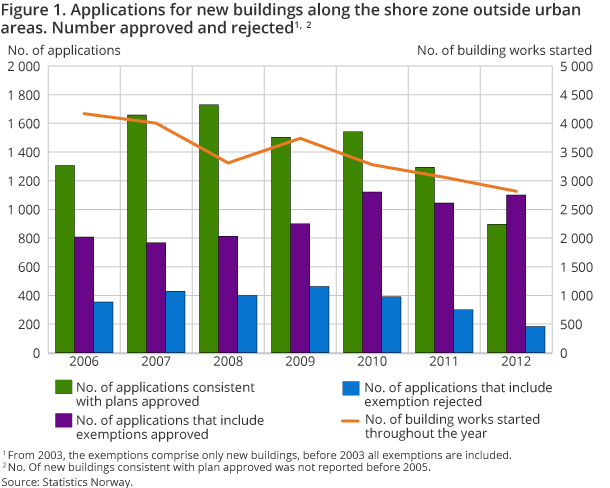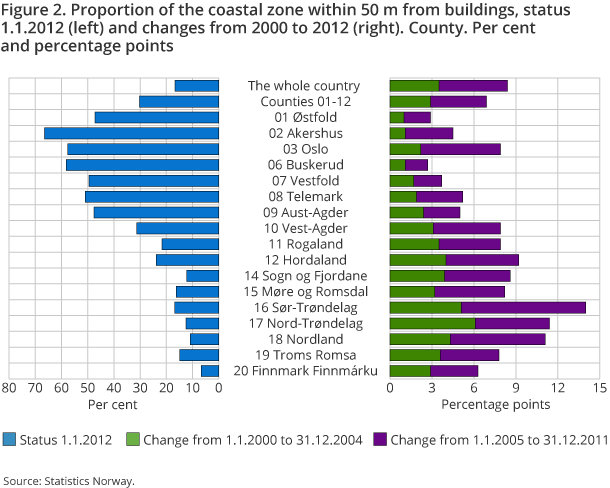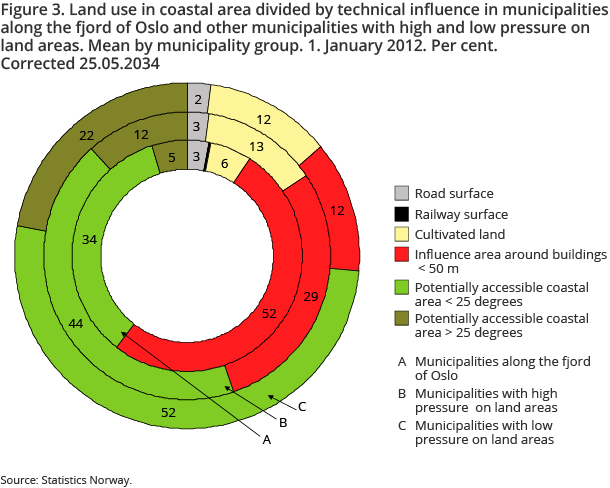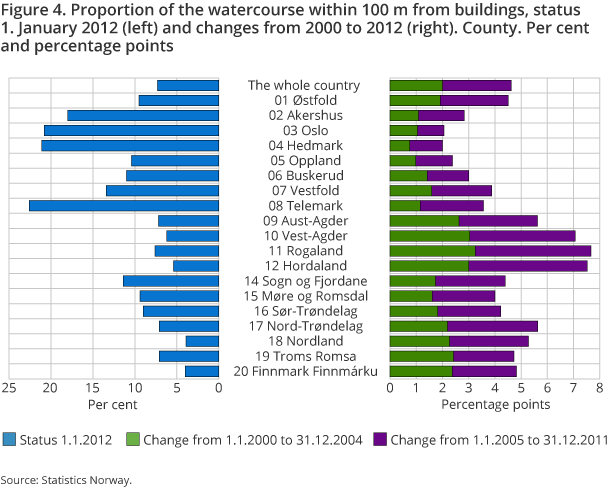Content
Published:
This is an archived release.
Less building activity in coastal zone
In 2010, the declining trend for building activity along the coast that started in 2006 continued after a rise in 2009. The increasing trend in the number of applications for exemptions for new buildings in the coastal zone since 2006 reversed in 2011. However, the proportion of granted applications increased in the same period.
| 2005 | 2011 | 2012 | |
|---|---|---|---|
| Buildings in the shore zone. Number | 461 694 | 492 321 | 495 935 |
| Influence area around buildings. Decare | 655 117 | 688 808 | 691 707 |
| Potentially accessible shore area. Decare | 2 917 049 | 2 861 025 | 2 858 127 |
| Percentage of applications for new buildings in the shore zone granted dispensation | 72 | 78 | 86 |
The number of building works started in the Norwegian coastal zone (land within 100 metres of the coastal line) decreased by a quarter between 2006 and 2011, according to the Cadastre. In 2011, 4 317 building works were started compared to 5 893 in 2006. Most counties experienced a decrease in building activity in the coastal zone in 2011 compared to the previous year. The most important exception is Aust-Agder, where building works started have increased in the last two years. Preliminary figures for 2012 show that 230 building works were started in Aust-Agder in 2012 compared to 170 in 2011 and 151 in 2010. In spite of a significant decrease in building activity in Hordaland, this remains the county with most building works started in the coastal zone.
Most building works within the coastal zone were started in areas outside built-up areas. In 2011, only 3 060 new building works were started compared to 4 169 in 2006. Holiday homes (cabins) are the most common building type outside built-up areas in the coastal zone.
Almost nine out of ten exemption applications for construction were improved
Estimates based on KOSTRA reporting show that local authorities received and approved an increasing number of exemption applications for construction in the coastal zone from 2006 to 2010. During the same period, the number of applications rose from 1 163 to 1 512. In 2011, fewer applications were reported (1 345), and in 2012 the number of applications fell to 1 284. The percentage of granted exemptions shows approximately the same trend and has increased from 2006 (70 per cent) to nearly 86 per cent in 2012. However, the share of approved applications is still increasing and in 2011 was nearly 78 per cent.
fig-2013-07-04-01-en; Applications for new buildings along the coastal zone outside urban areas. Number approved and rejected
Less space for outdoor activities
Despite the reduction in building activity, the coastal areas potentially accessible for outdoor activities are still shrinking. Areas influenced by buildings, railways, roads and agricultural land are regarded as areas that are not potentially accessible. From 2000 to 2012, the proportion of the coastal zone closer than 50 metres from buildings nearly doubled from 8.3 per cent in 2000 to 16.7 per cent at the beginning of 2011. The changes have been greatest in Sør-Trøndelag, where the proportion of areas closer than 50 metres from buildings has increased by almost 8.9 per cent since 2005.
Reduction in building activity also along the water courses
Until 2011, building activity had been increasing along the water courses of importance. In 2011, only 4 734 building works were started within a hundred metres of water courses of importance (Strahler code ≥ 3) compared to 5 371 the year before. With regard to the coastal zone, the proportion of watercourses close to buildings is greater in the Oslofjord region than in other parts of the country. However, in recent years the pressures on land have also increased in other parts of the country. In the period 2000 to 2012, the proportion of water courses within a hundred metres of a building has increased by more than seven per cent in Vest-Agder, Rogaland and Hordaland. This increase occurred despite the fact that a new Planning and Building Act came into force in July 2009, which includes a new section on restrictions in new building activities along water courses.
Only preliminary figures for 2012Open and readClose
Due to delays in the registration of building works from local authorities for 2012, national figures for 2012 are presented as preliminary. The figures in Statbank refer to the status as of 1 January of each year and include preliminary figures for 01.01.2013.
Contact
-
Tom Anders Engebakken
E-mail: tom.engebakken@ssb.no
tel.: (+47) 47 46 47 66
-
Jørn Kristian Undelstvedt
E-mail: jorn.kristian.undelstvedt@ssb.no
tel.: (+47) 94 50 68 64




